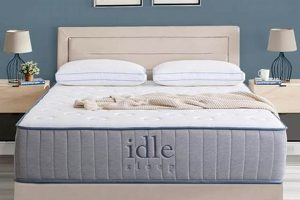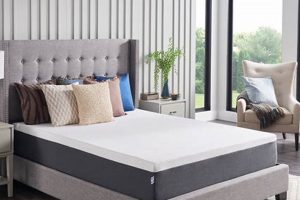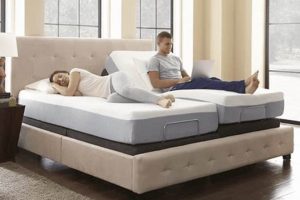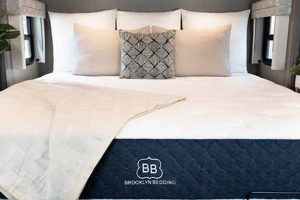The optimal sleep surface for a floor-based bed prioritizes support, breathability, and resistance to moisture accumulation. It differs significantly from a standard mattress intended for use with a box spring or platform frame. This type of bedding directly addresses the unique challenges posed by direct contact with the floor, ensuring a comfortable and hygienic sleep environment.
Selecting an appropriate sleep solution for floor placement is crucial for preventing mold growth and maintaining proper spinal alignment. It also contributes to improved air circulation around the mattress, mitigating potential allergy triggers and extending the lifespan of the product. Historically, floor sleeping was a common practice in many cultures; modern adaptations require careful consideration of materials and design to address contemporary needs.
The subsequent sections will explore key factors influencing mattress selection, including material composition, thickness, support levels, and necessary preventative measures for maintaining a clean and comfortable floor bed setup. Considerations for different sleep styles and individual needs will also be addressed.
Essential Considerations for Floor Bed Mattresses
Optimizing a sleep setup involves careful evaluation of specific factors. The following recommendations address key considerations when selecting a mattress for floor placement.
Tip 1: Material Composition is Paramount: Prioritize mattresses constructed with breathable, moisture-wicking materials. Natural latex, open-cell memory foam, or hybrid constructions with enhanced airflow are preferable. These materials minimize moisture buildup, reducing the risk of mold and mildew.
Tip 2: Thickness Influences Comfort and Support: A minimum thickness of eight inches is generally recommended to provide adequate support and cushioning when placed directly on the floor. Thicker mattresses may offer enhanced pressure relief but also increase the risk of trapping moisture.
Tip 3: Employ a Mattress Platform or Barrier: Direct contact with the floor can compromise hygiene and ventilation. Implementing a slatted platform or using a moisture-resistant underlayment provides a crucial barrier, promoting airflow and minimizing the potential for moisture accumulation.
Tip 4: Regular Cleaning and Maintenance are Essential: Regularly vacuum the surrounding floor area and the mattress surface to remove dust, debris, and potential allergens. Airing out the mattress periodically, ideally in direct sunlight, helps to inhibit mold growth and refresh the materials.
Tip 5: Consider a Waterproof Mattress Protector: A high-quality, breathable mattress protector is vital to safeguard the mattress from spills, sweat, and other potential sources of moisture. Ensure the protector allows for adequate airflow to prevent trapping humidity.
Tip 6: Monitor Ambient Humidity Levels: High humidity can exacerbate moisture-related issues. Utilize a dehumidifier in the sleeping area to maintain optimal humidity levels, particularly in humid climates or during periods of high humidity.
Tip 7: Prioritize Proper Ventilation: Adequate air circulation around the mattress is crucial. Avoid placing the bed in corners or against walls where airflow is restricted. Maximize ventilation by elevating the mattress periodically to allow for thorough drying.
Adhering to these recommendations ensures a cleaner, more comfortable, and healthier sleep environment when utilizing a floor-based mattress setup. These practices mitigate potential hygiene concerns and prolong the lifespan of the mattress.
The next section will address specific mattress types suitable for floor placement, providing a comparative analysis of their respective advantages and disadvantages.
1. Support and Alignment
Adequate support and spinal alignment are paramount when selecting a mattress for floor placement. Unlike traditional bed frames, a floor bed lacks the give and support of a box spring or platform. Therefore, the mattress itself must provide the necessary structural integrity to maintain proper posture during sleep. Insufficient support can lead to misalignment of the spine, resulting in back pain, muscle stiffness, and discomfort. The primary purpose is to mimic the natural curve of the spine.
Mattresses designed with zoned support systems or those incorporating firmer materials in the lumbar region directly address this need. These features ensure that the hips and shoulders sink in appropriately while maintaining support for the lower back. For example, a medium-firm latex mattress can provide both contouring and robust support, promoting a neutral spine position. In contrast, a very soft mattress may cause excessive sinking, leading to spinal misalignment and discomfort. Proper spinal alignment prevents the development of long-term musculoskeletal issues.
In summary, prioritizing support and alignment is crucial when choosing a floor bed mattress. The mattress must provide the structural foundation necessary for maintaining proper spinal posture. Failure to do so can result in discomfort and potential long-term health issues. The selection process should emphasize mattresses with features designed to promote spinal alignment, ensuring a healthy and restorative sleep experience.
2. Moisture Resistance
Moisture resistance is a critical determinant in evaluating mattress suitability for floor placement. Direct contact with the floor increases the risk of moisture absorption, which can lead to mold growth, bacterial proliferation, and material degradation. Selecting a mattress with inherent moisture-resistant properties is essential for maintaining hygiene and extending the product’s lifespan.
- Material Permeability
Mattress materials vary significantly in their permeability to moisture. Open-cell structures, such as those found in certain types of latex or specialized memory foam, allow for greater airflow and facilitate the evaporation of moisture. Conversely, closed-cell materials, like traditional memory foam, tend to trap moisture, creating a conducive environment for microbial growth. Material selection should prioritize breathability to minimize moisture accumulation. For example, natural latex exhibits inherent moisture-wicking properties, making it a suitable choice for floor beds.
- Environmental Factors
Ambient humidity levels play a significant role in the accumulation of moisture within a mattress. Environments with high humidity exacerbate the risk of moisture absorption, necessitating the use of mattresses with enhanced moisture resistance. In such conditions, additional preventative measures, such as the use of dehumidifiers and breathable mattress protectors, are advisable. Conversely, in drier climates, the risk of moisture accumulati
on is reduced, although selecting a moisture-resistant mattress remains prudent. - Protective Barriers
The use of protective barriers, such as waterproof or water-resistant mattress covers, is a crucial strategy for mitigating moisture-related risks. These barriers prevent liquids and moisture from penetrating the mattress core, safeguarding against mold growth and material degradation. However, it is essential to select breathable protective covers that allow for adequate airflow to prevent trapping moisture between the cover and the mattress surface. Non-breathable covers can create a humid environment, negating the benefits of moisture-resistant mattress materials.
- Maintenance and Ventilation
Regular maintenance and ventilation are essential for minimizing moisture accumulation in floor beds. Periodic airing of the mattress, ideally in direct sunlight, helps to evaporate any accumulated moisture and inhibit mold growth. Vacuuming the mattress surface regularly removes dust and debris that can trap moisture. Elevating the mattress periodically, even temporarily, allows for increased airflow underneath, further reducing the risk of moisture buildup. Neglecting these maintenance practices can compromise the moisture resistance of even the most suitable mattress materials.
In conclusion, moisture resistance is a multifaceted consideration when selecting bedding for floor beds. Appropriate mattress materials, coupled with protective barriers and diligent maintenance practices, are crucial for maintaining hygiene, preventing mold growth, and extending the lifespan of the product. Failing to address moisture-related risks can compromise sleep quality and potentially lead to health issues. Therefore, selecting a moisture-resistant mattress is a fundamental requirement for creating a safe and comfortable floor sleeping environment.
3. Breathability
Breathability, as a property of mattress materials and construction, directly influences the suitability of a mattress for floor bed use. A mattress lacking adequate breathability traps heat and moisture, fostering an environment conducive to microbial growth and discomfort. When a mattress rests directly on the floor, the absence of airflow beneath exacerbates this issue. Therefore, the breathability characteristic is essential for maintaining a hygienic and comfortable sleep surface.
Mattresses constructed with open-cell foam, natural latex, or innerspring systems generally exhibit superior breathability compared to those made with dense memory foam or entirely closed-cell materials. Open-cell structures allow for greater air circulation within the mattress, facilitating the evaporation of moisture and dissipation of heat. For instance, a natural latex mattress placed on the floor demonstrates better temperature regulation and moisture control compared to a traditional memory foam mattress under similar conditions. This difference stems from the inherent structure of latex, which promotes airflow. Further practical application includes the use of slatted platforms or ventilated underlays, creating a buffer zone between the mattress and the floor, thereby enhancing breathability.
In summary, breathability is an indispensable feature of a mattress designed for floor placement. The lack of ventilation inherent in floor bed setups underscores the need for materials and designs that actively promote airflow and moisture management. Failure to prioritize breathability compromises hygiene, comfort, and the longevity of the mattress itself. This understanding highlights the importance of selecting mattresses with open-cell structures, employing ventilated underlays, and implementing regular maintenance practices to ensure a healthy and comfortable sleep environment.
4. Thickness and Height
The thickness and height dimensions of a mattress significantly impact its suitability as the “best mattress for floor bed.” Insufficient thickness compromises support and comfort, as the floor provides no give. Conversely, excessive height may create challenges in accessing the bed and can exacerbate issues related to heat retention and moisture accumulation. A well-chosen thickness must balance these competing factors to ensure optimal sleep quality and longevity of the mattress. The goal is to select a thickness that offers sufficient cushioning and support while minimizing the risks associated with floor placement.
A mattress thickness of at least eight inches is generally recommended for floor beds. This provides sufficient material to offer adequate support for most individuals, preventing direct pressure on joints and promoting proper spinal alignment. Some individuals may require a greater thickness, particularly those who are heavier or who prefer a plusher sleeping surface. However, exceeding a certain thickness threshold, generally around 12 inches, can reduce airflow around the mattress, increasing the potential for moisture buildup. A real-world example involves comparing an eight-inch latex mattress to a twelve-inch memory foam mattress on the floor. The latex mattress, despite being thinner, often provides better support and breathability due to its material properties, illustrating that thickness alone is not the sole determinant of quality. This implies that material composition interacts with the thickness attribute. When a thicker mattress is selected, adequate consideration for the materials, ventilation, and weight must also be considered.
In conclusion, thickness and height are critical considerations in selecting a mattress for floor use. A balanced approach, considering both the need for adequate support and the potential for moisture-related issues, is essential. While a minimum thickness is necessary to ensure comfort, excessive height can introduce new challenges. Careful consideration of material composition, ventilation strategies, and individual preferences is crucial to selecting a mattress that provides both support and a healthy sleep environment. The optimal thickness range generally falls between eight and twelve inches, depending on individual needs and mattress material, showcasing the multifactorial elements of selecting the best mattress for floor bed.
5. Material Composition
Material composition is a primary determinant in defining the suitability of a mattress for floor bed applications. The inherent properties of the materials used directly impact crucial factors such as breathability, moisture resistance, support, and durability. The characteristics exhibited by each component collectively determine the overall performance and longevity of the product in a floor-based setting. The wrong material selection leads directly to issues like mold growth, discomfort due to heat retention, and premature degradation of the mattress structure. Consequently, the appropriate material selection is essential for creating a healthful and enduring sleep environment. Consider natural latex, known for its breathability and resilience, often regarded as an excellent material for floor beds. In contrast, a low-density polyurethane foam would likely lead to poor support and rapid compression, rendering it an unsuitable choice.
The selection process must consider the interaction bet
ween different materials within a single mattress. Hybrid models, combining innerspring systems with layers of memory foam or latex, require careful evaluation to ensure each component complements the others. For example, pairing a highly breathable innerspring core with a thin layer of open-cell memory foam can provide both support and adequate airflow. However, if the memory foam layer is too thick or lacks breathability, it can negate the benefits of the innerspring system. Furthermore, the textile used for the mattress cover plays a critical role. Natural fibers, such as cotton or bamboo, are preferable to synthetic materials, as they enhance breathability and moisture-wicking capabilities. For example, a floor bed with a cotton cover minimizes moisture trapping while a polyester cover tends to trap heat inside, creating an uncomfortable sleeping experience.
In conclusion, material composition exerts a profound influence on the suitability of a mattress for floor bed usage. Strategic material selection promotes healthy airflow, offers mold and microbial protection and extends the product lifespan. By paying meticulous attention to the properties of each component and how they interact, consumers can optimize their sleep environment and ensure their well-being. Without this focus, even a seemingly well-designed mattress can prove inadequate for floor-based setups, leading to discomfort, hygiene concerns, and financial loss. Consequently, prioritizing material composition is paramount in selecting the best mattress for floor bed needs.
6. Mold Prevention
Mold prevention is a critical factor in determining the suitability of any mattress for floor placement. The proximity to the floor increases the risk of moisture accumulation, creating a conducive environment for mold and mildew growth. Effective mold prevention strategies are, therefore, essential in maintaining a hygienic and healthy sleep environment when utilizing a floor bed.
- Material Selection for Reduced Moisture Retention
Mattress materials that resist moisture absorption are paramount in mold prevention. Natural latex, open-cell memory foam, and hybrid constructions incorporating breathable materials minimize moisture retention. These materials facilitate air circulation within the mattress, allowing moisture to evaporate rather than accumulate and fostering microbial growth. The use of closed-cell memory foam, on the other hand, increases the risk of mold due to its tendency to trap moisture. The choice of mattress material directly impacts the likelihood of mold proliferation in a floor bed scenario.
- Ventilation Strategies for Floor Beds
Adequate ventilation beneath the mattress is crucial for preventing moisture buildup and mold growth. Direct contact with the floor restricts airflow, necessitating the implementation of strategies to enhance ventilation. Using a slatted platform or a breathable underlayment between the mattress and the floor provides a crucial air gap, promoting evaporation of moisture. Regular lifting and airing of the mattress, especially in humid climates, further reduces the risk of mold formation. Limited ventilation will likely lead to moisture accumulation and mold problems.
- Humidity Control in the Sleeping Environment
Maintaining optimal humidity levels in the sleeping area is essential for mold prevention. High humidity exacerbates moisture accumulation in the mattress, creating a favorable environment for mold growth. Employing a dehumidifier in the bedroom, particularly during periods of high humidity, helps to regulate moisture levels and minimize the risk of mold formation. Monitoring humidity levels with a hygrometer allows for proactive adjustments to maintain a dry and healthy sleeping environment. Without proper humidity controls, the mattress is more susceptible to mold issues.
- Regular Cleaning and Maintenance Practices
Routine cleaning and maintenance are vital for preventing mold growth in floor beds. Regularly vacuuming the mattress surface removes dust, debris, and potential mold spores. Spot cleaning spills promptly prevents moisture from penetrating the mattress core. Allowing the mattress to air out in direct sunlight periodically inhibits mold growth by drying out any accumulated moisture. Neglecting regular cleaning and maintenance significantly increases the risk of mold infestation.
The connection between mold prevention and selecting the best mattress for floor bed is direct. Choosing a mattress with appropriate materials, implementing effective ventilation strategies, controlling humidity levels, and adhering to a regular cleaning schedule are all essential components of a holistic mold prevention approach. A failure to address these factors compromises the hygiene and healthfulness of the sleep environment, potentially leading to respiratory issues and other health concerns. Prioritizing mold prevention is, therefore, an integral aspect of selecting a suitable mattress for floor placement, demonstrating the essential elements for achieving a long-lasting, safe, and effective sleeping arrangement.
Frequently Asked Questions About Mattresses for Floor Beds
The following section addresses common inquiries regarding the selection and maintenance of mattresses specifically designed for floor placement. These questions aim to provide clarity and informed guidance for consumers considering this type of sleeping arrangement.
Question 1: Is a box spring necessary when using a mattress on the floor?
No, a box spring is not required and is generally not recommended for floor beds. The primary purpose of a box spring is to provide support and elevation for a mattress within a traditional bed frame. Direct placement on the floor negates the need for this support structure. Furthermore, using a box spring on the floor can impede airflow and increase the risk of moisture accumulation.
Question 2: What type of mattress is most suitable for a floor bed?
Mattresses made from natural latex or those with open-cell memory foam constructions are generally considered optimal for floor beds. These materials promote breathability and resist moisture absorption, mitigating the risk of mold and mildew growth. Hybrid mattresses with innerspring systems can also be suitable, provided they incorporate layers of breathable materials.
Question 3: How can mold growth be prevented when using a mattress on the floor?
Mold prevention involves several key strategies. Selecting a mattress with breathable and moisture-resistant materials is crucial. Utilizing a slatted platform or a breathable underlayment between the mattress and the floor enhances ventilation. Maintaining optimal humidity levels in the sleeping environment and regularly airing out the mattress further reduces the risk of mold formation.
Question 4: What is the recommended thickness for a floor bed mattress?
A minimum thickness of eight inches is generally recommended to provide adequate support and cushioning when placing a mattress directly on the floor. Thicker mattresses may offer enhanced pressure relief but can also increase the risk of trapping moisture. The optimal thickness balances support needs with ventilation considerations.
Question 5: How often should a floor bed mattress be cleaned?
A floor bed mattress should be vacuumed regularly, ideally once a week, to remove dust, debris, and potential allergens. Spills should be spot-cleaned promptly to prevent moisture penetration. The matt
ress should also be aired out periodically, preferably in direct sunlight, to inhibit mold growth and refresh the materials.
Question 6: Does a floor bed mattress require a special type of cover?
Yes, a breathable, waterproof or water-resistant mattress protector is highly recommended for floor bed mattresses. This type of cover safeguards the mattress from spills, sweat, and other potential sources of moisture, while still allowing for adequate airflow. Avoid covers made from non-breathable materials, as they can trap moisture and promote mold growth.
In summary, selecting and maintaining a mattress for floor placement requires careful consideration of materials, ventilation, and hygiene practices. Adhering to these guidelines ensures a comfortable, healthy, and long-lasting sleep environment.
The subsequent section will address specific purchasing considerations and factors to evaluate when selecting a floor bed mattress from various retailers.
Selecting the Optimal Floor Bed Mattress
The preceding exploration has elucidated essential factors in determining the “best mattress for floor bed.” Material composition, thickness, breathability, support, and mold prevention emerge as the cornerstones of informed decision-making. Prioritizing these aspects ensures a sleep surface that promotes both physical well-being and long-term hygiene, critical considerations for floor-based setups. Thorough assessment of these parameters constitutes a responsible approach to selecting bedding.
Ultimately, the investment in a well-suited floor bed mattress represents an investment in individual health and environmental sustainability. Continued diligence in adhering to recommended maintenance practices further safeguards this investment, fostering a sleep environment that is both comfortable and conducive to long-term wellness. The informed consumer recognizes that the appropriate mattress choice yields benefits far beyond immediate comfort, contributing to enduring health and responsible resource utilization.




![Top-Rated: Best Foam Mattress for Camping - [Year] Guide Organic & Natural Mattress Buyer’s Guide: Non-Toxic Sleep Solutions Top-Rated: Best Foam Mattress for Camping - [Year] Guide | Organic & Natural Mattress Buyer’s Guide: Non-Toxic Sleep Solutions](https://mattressworldpa.com/wp-content/uploads/2025/07/th-7661-300x200.jpg)


